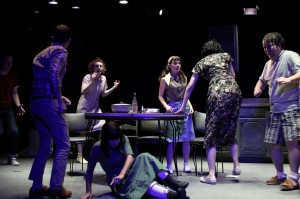The Lethality of the Ordinary
Upon entering the theater, audience members received a program with an insert containing a brief description of the story about to unfold. On the reverse, a facsimile of a handwritten letter explained how Casey, the victim, acquired marks on her stomach that read, “I am a prostitute and proud of it.”
 Providing the plot outline before the lights go out removes a major source of dramatic tension and situates the focus on character development and relationship exposition. Based on a crime committed in 1965, Down There (at the Axis Theater Company), imagines answers to questions posed by the murder of teenager Sylvia Marie Likens: “How could a diverse group of people of various ages who went to school, interacted with others, had their own families, ate snacks and played return daily to a basement and torture a girl to death? And: Why didn’t Sylvia run away? What was in her personal condition that allowed her to understand her abuse as something normal?” (From the press release.)
Providing the plot outline before the lights go out removes a major source of dramatic tension and situates the focus on character development and relationship exposition. Based on a crime committed in 1965, Down There (at the Axis Theater Company), imagines answers to questions posed by the murder of teenager Sylvia Marie Likens: “How could a diverse group of people of various ages who went to school, interacted with others, had their own families, ate snacks and played return daily to a basement and torture a girl to death? And: Why didn’t Sylvia run away? What was in her personal condition that allowed her to understand her abuse as something normal?” (From the press release.)
To solve that mystery, writers Randy Sharp and Michael Gump conjured up the Menckl family, whose pathological dynamics make it well qualified to kill. One formed by accretion rather than procreation, it consists of Pat, the long-suffering mother; Frank, the disabled, unemployed, alcoholic father; and Jim, the developmentally disabled son with psychiatric problems. Acquired members include John, Rickie and Paula, older teenagers, soon joined by polio-stricken Joyce and her protective 16-year-old sister Casey. These relationships coalesce slowly, leaving viewers in an unsettled state not unlike that of those on stage.
The action reveals how one person’s rage has the power to infect others. Pat projects her own misery onto those around her and enlists her charges to assist her in scapegoating and eventually killing a child she agreed to foster. She viciously berates Paula for eating candy, calling her a fat girl who nobody will want. Endlessly complaining about her various ailments, she takes pain pills to cope with a bad back and Jim’s pills for her nerves. Attracting stray children for the money their care brings, she seethes with resentment over the insufficiency of the remuneration and directs her anger at the kids and Frank.
When Casey arrives, she brings with her a certain vibrancy and sense of entitlement that immediately irritates Pat, who accuses her of coming on to the boys in the house. Meanwhile, Pat embraces Jim more like a lover than a son. As time goes on, Pat observes that Frank’s drinking picked up after Casey’s arrival and blames the child for that, too.
 None of it makes any sense and yet the chaos enacted leads inexorably toward the imprisonment of Casey in the basement and the deprivation and abuse that result in her slow and painful death. The audience finds itself caught up in the vortex of fast-paced, disjointed action, drawn into the role of helpless bystander. After the play ended, many remained fixed in their seats, too stunned to move.
None of it makes any sense and yet the chaos enacted leads inexorably toward the imprisonment of Casey in the basement and the deprivation and abuse that result in her slow and painful death. The audience finds itself caught up in the vortex of fast-paced, disjointed action, drawn into the role of helpless bystander. After the play ended, many remained fixed in their seats, too stunned to move.
How closely do these fictional characters resemble the actual participants in the 1965 crime? If not taken from life, how ever were they dreamed up?
In an interview, writer and director Sharp explained her need to figure out how terrible things occurred. “They’re more frightening if they’re inexplicable, less scary if you can figure out why things happened.” Back in the ’60s when she first learned about the murder of Sylvia Likens, it blew her mind that it had taken three months for the victim to succumb and that during that time, nobody noticed.
She imagined the dialog and, using the information available about Gertrude Baniszewski, the real mother, she created a character that retained some of her personality, including the pill popping and eating disorder (anorexia). Gertrude didn’t have a developmentally disabled son and the neighborhood children who participated were many and as young as 11.
Running an online search on Sylvia reveals memorial websites, some with detailed information about the fate of the murderers. Apparently Sharp wasn’t the only one appalled and perplexed by the ability of one woman to mastermind the death of a teenager in this way.
In her drive to understand the minds of these perpetrators, Sharp successfully deployed a cast of characters with the right mix of ordinariness and strangeness to account for the invisibility and lethality that enabled them to torture and murder in plain sight.
Down There
Axis Theater
1 Sheridan Square
New York, NY 10014
(212)887-9300

